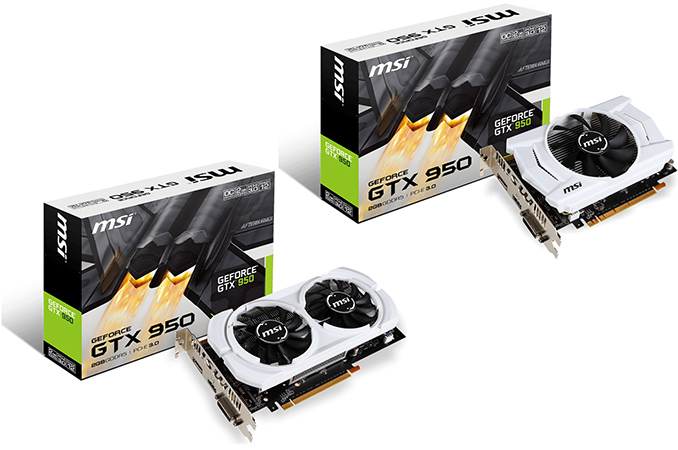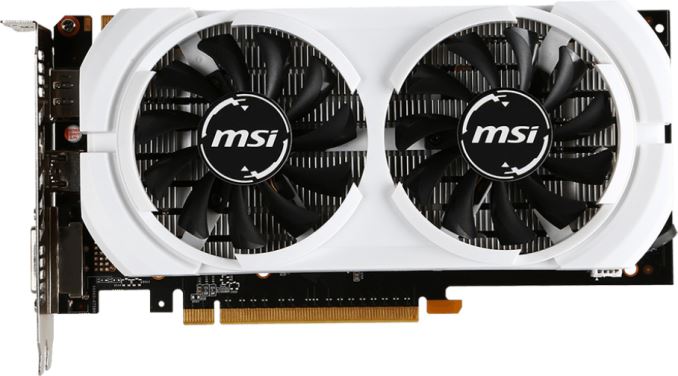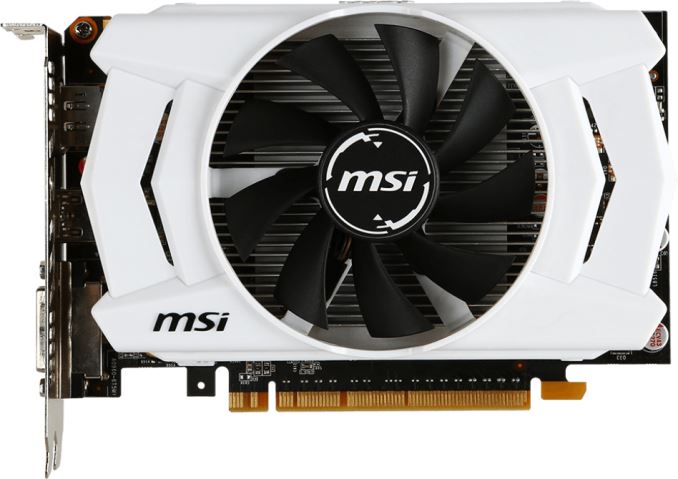MSI Introduces two new GTX 950 2GB GPUs with 75W TDP: the OCV2 and OCV3
by Anton Shilov on March 16, 2016 12:00 PM EST
A standard GTX 950 reference design comes in at a 90W TDP, which means it requires a 6-pin PCIe power connector as the standard PCIe slot is typically rated to only provide 75W. However, we have seen a couple of AIB partners introducing new 75W versions of the GTX 950 to come in under the limit, and as a result remove the 6-pin PCIe connector needed. One of those is MSI, who has introduced two new video cards that can be powered solely by the PCI Express connection. The low-power GeForce GTX 950 graphics boards from MSI follow similar graphics adapters from ASUS and indicate that there are NVIDIA’s GM206-251 GPUs. At this point we might conclude that the '251' nomenclature refers to the specific silicon design which might afford lower power operation.
The two new cards from MSI are the GeForce GTX 950 2GD5T OCV3 and the MSI GeForce GTX 950 2GD5T OCV2 and are based on the GeForce GTX 950 (GM206) in its default configuration: 768 stream processors, 48 texture units, 32 ROPs as well as a 128-bit GDDR5 memory interface. The GPUs of both cards are clocked at 1076 MHz, but can increase their frequencies to 1253 MHz in boost mode. Both graphics adapters are equipped with 2 GB of GDDR5 memory clocked at 6.6 Gbps, a dual-slot cooling system with an aluminum heatsink, one DVI connector, one HDMI 2.0 port and one DisplayPort output. As mentioned above, neither of the boards require additional PCIe power connectors and their TDP does not exceed 75 W.
The two cards differ in their cooling and length. The first one is the GTX 950 2GD5T OCV3 uses a dual fan design and features a longer PCB which is designed to focus on a typical desktop PC. The shorter GTX 950 2GD5T OCV2 uses a single fan and seems to be designed for mini-ITX systems. Thanks to the fact that the GM206 GPU features hardware-accelerated decoding and encoding of H.265 (HEVC) video and fully supports HDCP 2.2 content protection over HDMI 2.0, the OCV2 card could be a fine choice for small form-factor home-theater PCs.
That being said we have noticed that on the stock photographs that the smaller model eliminates some of the PCI Express pins for an unknown reason, so the exact feature-set is to be confirmed. We have put questions to MSI on this and will update when we have a response.
Graphics cards based on the GeForce GTX 950 GPUs with lowered power consumption can be used not only to build SFF HTPCs, but also to upgrade cheap desktop systems, which sometimes do not have a spare PCIe power connector inside. Previously NVIDIA’s partners only offered GeForce GTX 750 Ti without auxiliary power connectors, but this adapter is already two years old, and its performance may not enough for modern titles.
Now there are (at least) two graphics cards suppliers who offer GeForce GTX 950 adapters with lowered power consumption, it is likely that other companies will follow them as well. It is unclear whether NVIDIA officially sells GM206 GPUs with low TDP to address the market of entry-level desktops, or companies like ASUS or MSI simply hand-pick GPUs that do not need more than 75 W of power to function properly. In any case, it is evident that such GPUs exist and are in demand enough that the AIB partners want to produce them.
| NVIDIA Video Card Specification Comparison | |||||||
| MSI GTX 950 OCV2/3 | ASUS GTX950-2G | Ref GTX 950 |
Ref GTX 960 |
Ref GTX 750 Ti |
|||
| CUDA Cores | 768 | 1024 | 640 | ||||
| Texture Units | 48 | 64 | 40 | ||||
| ROPs | 32 | 16 | |||||
| Core Clock | 1076 MHz | 1026 MHz | 1024 MHz | 1126 MHz | 1020 MHz | ||
| Boost Clock | 1253 MHz | 1190 MHz | 1188 MHz | 1178 MHz | 1085 MHz | ||
| Memory Clock | 6.6 Gbps GDDR5 |
7 Gbps GDDR5 |
5.4 Gbps GDDR5 |
||||
| Memory Bus Width | 128-bit | ||||||
| VRAM | 2 GB | 2/4 GB | 2 GB | ||||
| TDP | 75 W | 90 W | 120 W | 60 W | |||
| Architecture | Maxwell 2 | Maxwell 1 | |||||
| GPU | GM206 | GM107 | |||||
| Transistor Count | 2.94 B | 1.87B | |||||
| Manufacturing Process | TSMC 28nm | TSMC 28nm | |||||
| Launch Date | 03/16/16 | 03/16/16 | 08/20/15 | 01/22/15 | 02/18/14 | ||
| Launch Price | unknown | unknown | $159 | $199 | $149 | ||
Exact prices and release dates of MSI’s GeForce GTX 950 2GD5T OCV3 and GeForce GTX 950 2GD5T OCV2 graphics cards are unknown. Keeping in mind that the boards are not exclusive products available only from MSI, their prices will hardly be very high and will be near the GTX 950’s MSRP of $159.
Source: MSI


















12 Comments
View All Comments
Amoro - Wednesday, March 16, 2016 - link
No low profile option? Is the TDP still too high for singleslot?close - Wednesday, March 16, 2016 - link
It's too high for single slot AND silent operation. I guess this kind of card would fit nicely in a more silent PC and the extra slot is less of a problem for most recent systems.nissefar - Wednesday, March 16, 2016 - link
My GTX 750 is silent enough and is single fan. A dual fan low profile should easily be possible, I think MSI even had a dual fan low profile GTX 750.DanNeely - Wednesday, March 16, 2016 - link
I'm curious what the actual power draw for 75W cards is. The spec says that the 75W max is supposed to break down as up to 65W @12V and 10W @ 3.3V (equivalent to what a legacy PCI card could draw - presumably originally to make porting cards via bridge chips easier when PCIe 1.0 came out a decade ago). Do these cards actually draw 10W on the 3.3V rail, or do they overdraw at 12V at full load?If someone had a card and a clamp amp meter it would probably be easy enough to check if using a PSU with separately wrapped wires in the 24 pin connector, because AFAIK almost nothing in a modern system draws from that rail anymore; so a 3A bump when using one of these cards vs the IGP should be fairly clear.
ruthan - Wednesday, March 16, 2016 - link
Today's world.. lots of text and lots of numbers.. but all of that is only PR crap any real details how it actually works and how is possible to reach only 75W.stardude82 - Thursday, March 17, 2016 - link
Binning and aggressive power throttling. The stated frequencies have very little bearing to real world performance as even at 90W the card throttles heavily under load.Daniel Egger - Wednesday, March 16, 2016 - link
Pray tell, why would anyone need a GTX 950 in a machine without additional PCIe connectors? I know those pre-assembled systems used to exist but they're typically so underpowered that even a 750 Ti would be bored to death... If you buy a system nowadays which can optionally be obtained with higher performance GPUs and do typically have the punch to run them they they almost certainly do provide at least one 6-pin connection, we're not really talking about crazy stuff like requiring 3 8-pin connections here where one needs rather special PSUs...Quite frankly I'd rather take a regular GTX 950 with the connector just for the sake of ensuring system stability and actually being able to use the offered OC.
RafaelHerschel - Wednesday, March 16, 2016 - link
Not needing a cable is convenient. Lower power probably means less heat, which is a plus for small cases or cases with limited cooling.I'm actually interested in these cards, I often buy decent systems build to specification (reliability is important) for specific projects and after a few years those PCs are no longer needed.
With a GTX 750, GTX 750 Ti or a low power GTX 950 these systems make good gaming systems for older games or MOBA's.
One of my clients gives his old PCs away for free to his employees and they are quite happy with a gaming PC for the price of a video card.
Valantar - Thursday, March 17, 2016 - link
Any modern CPU - even a dual core Pentium (or even a Bay Trail quad core) - can gain massively from the step up from GTX 750ti to GTX 950. Sure, a more powerful CPU would probably gain even more. But unless all you do is RTS, the GTX 750ti is NOT CPU limited on low end desktops today. And even with the utterly crap PSUs that these come with (hence no PCIe connectors), they can easily power the ~140W these require while gaming.lagittaja - Wednesday, March 16, 2016 - link
And still no LP GTX 950.Argh, we need a native HDMI 2.0 LP card.
Should easily be doable with a dual fan solution like they had with GM107.